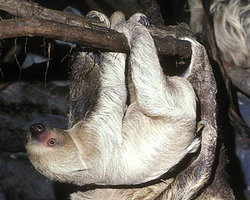Sloth
Sloths are medium-sized South American mammals belonging to the families Megalonychidae and Bradypodidae, part of the order Xenarthra. Sloths are herbivores, eating very little other than leaves. more...
Sloths have made extraordinary adaptations to an arboreal browsing lifestyle. Leaves, their main food source, provide very little energy or nutrition and do not digest easily: sloths have very large, specialized, slow-acting stomachs with multiple compartments in which symbiotic bacteria break down the tough leaves. Sloths may also eat insects and small lizards and carrion. As much as two thirds of a well-fed sloth's body-weight consists of the contents of its stomach, and the digestive process can take as long as a month or more to complete. Even so, leaves provide little energy, and sloths deal with this by a range of economy measures: they have very low metabolic rates (less than half of that expected for a creature of their size), and maintain low body temperatures when active (30 to 34 degrees Celsius), and still lower temperatures when resting.
Sloths move only when necessary and then very slowly: they have about half as much muscle tissue as other animals of similar weight. They can move at a higher speed, which still isn't all that fast, if they are in immediate danger from a predator, but they burn large amounts of energy doing so. Their specialized hands and feet have long, curved claws to allow them to hang upside-down from branches without effort. While they sometimes sit on top of branches, they usually eat, sleep and even give birth hanging from limbs. They are particularly partial to nesting in the crowns of palm trees where they can camouflage as a coconut. They come to the ground, to urinate and defecate, only about once a week.
Sloth fur also exhibits specialized functions: the outer hairs grow in the opposite direction to that of other mammals, i.e. pointing away from their extremities (so as to provide protection from the elements despite living legs-uppermost), and in moist conditions host two species of symbiotic cyanobacteria, which may provide camouflage. Ocassionally wild sloths appear to have a green tinge to their fur because of the presence of these bacteria.
Their claws also serve as their only natural defence. A cornered sloth may swipe at its attackers in a usually futile effort to scare them away. Despite sloths' apparent defencelessness, predators do not pose special problems: in the trees sloths have good camouflage and, moving only slowly, do not attract attention. Only during their infrequent visits to ground level do they become vulnerable. The main predators of sloths are the jaguar, the harpy eagle, and humans. The majority of sloth deaths in Costa Rica are from sloths getting into electrical lines and from poachers. Despite their adaptation to living in trees, sloths make competent swimmers.
Infant sloths normally cling to their mother's fur, but occasionally fall off. Sloths are very sturdily built and very few die from the fall. In some cases they die from the fall indirectly because the mothers sometimes prove unwilling to leave the safety of the trees to retrieve them.
Read more at Wikipedia.org


